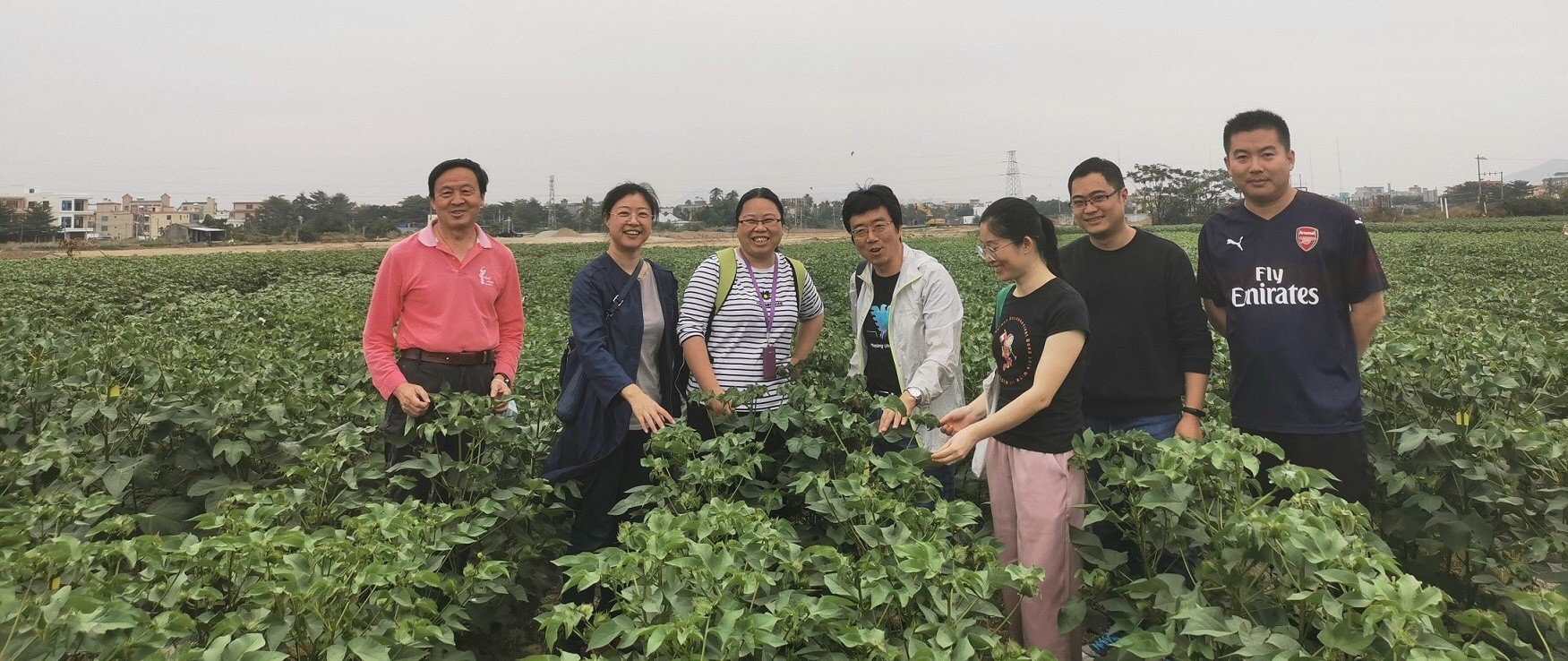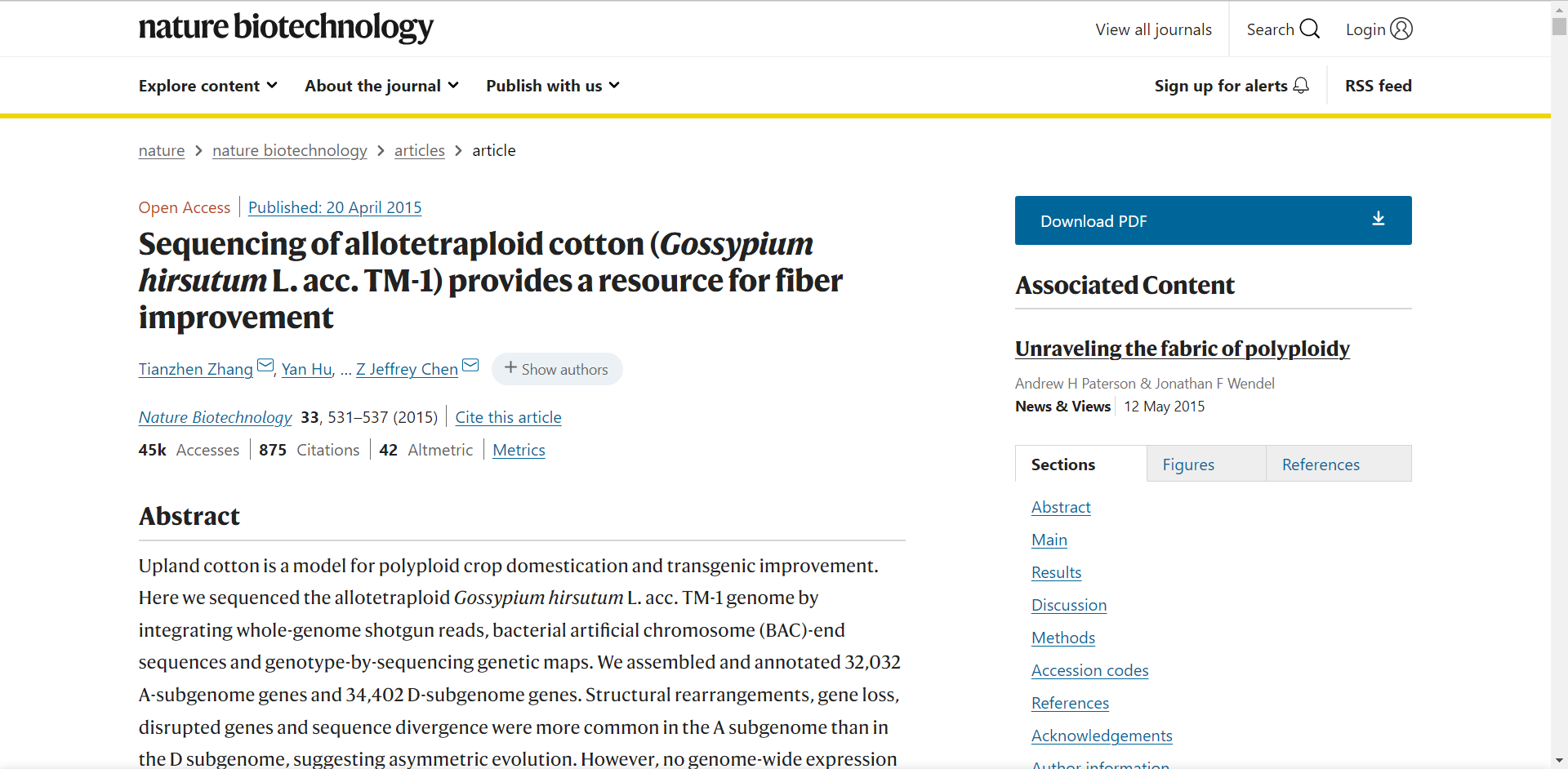Welcome to cotton omics
Brief Introduction of Research
Tianzhen Zhang
Research direction 1: plant genome research
Carry out research on cotton structural genome, gene cloning and functional verification of important traits, polyploid inheritance and molecular evolution, bioinformatics and so on.
Research direction 2: molecular breeding research
Research on new theories and methods of molecular marker mapping of important genes, assisted breeding and transgenic gene breeding.
Research direction 3: transgenic breeding
Carry out research and development of new genetic transformation systems, functional verification of target genes, and creation of new transgenic materials and varieties.
Research direction 4: Germplasm Innovation and utilization
Through interspecific introgression, physical and chemical mutation, T-DNA insertion mutation and recurrent selection of distant hybridization, new germplasm was created, identified and used.
Educational Experience
- 1987/03 - 1991/03: Nanjing Agricultural University, crop genetics and breeding, doctor, tutor:Jiaju Pan
- 1983/09 - 1986/09: Nanjing Agricultural University, crop genetics and breeding, master, tutor:Jiaju Pan
- 1978/10 - 1982/07: Nanjing Agricultural University, crop genetics and breeding, bachelor
Professional Experience
- 2016/3-present:Qiushi distinguished professor, Department of Agronomy, College of agriculture and biotechnology, Zhejiang University
- 1994/12 -2016/3: Professor, College of agriculture, Nanjing Agricultural University
- 1992/07 - 1994/12: Associate Professor, Department of Agronomy, Nanjing Agricultural University
- 1992/09 - 1993/09: Marie Curie scholarship winner, postdoctoral, Ruhr University, Germany
Xueying Guan
Hybridization and genome polyploidy are the main driving forces of genome evolution and the basis of Heterosis and polyploidy, which greatly enriches the species diversity in nature. Cotton, wheat, rape and other major grain, cotton and oil crops are typical allopolyploid species. At present, the main crop breeding is facing the problems of narrow genetic background and serious homogenization, which threatens the independent development of China's agricultural seed industry.
After the distant hybridization and polyploidization of diploid ancestral species, cotton has been significantly improved in fiber quality, fiber yield and adaptability, which is a typical embodiment of polyploid advantage. Therefore, cotton is also a model material for polyploid biology research.
The research group took allotetraploid cotton as the object to study the molecular mechanism of polyploid dominance. The main research results include:
(1) The regulation of asymmetric expression of polyploid cotton genome was revealed;(2) The activation and new functionalization of noncoding genes in polyploid genome were found, and the epigenetic basis of polyploid dominance was revealed;
(3) The molecular model of polyploid asymmetry regulating cotton fiber development was found, and the molecular mechanism of the formation of yield and quality traits of polyploid cotton was revealed.
Educational Experience
- 2002.9-2008.7 Doctor, State Key Laboratory of plant molecular genetics, Shanghai Institute of plant physiology and ecology, Chinese Academy of Sciences
- 1998.9-2002.7 Bachelor of biology, Department of Biochemistry, Central University for nationalities, China
Professional Experience
- 2019.11-present Zhejiang University, College of agriculture and biotechnology, researcher and doctoral supervisor of "Hundred Talents Program"
- 2014.9-2019.9 Professor and doctoral supervisor, College of agriculture, Nanjing Agricultural University
- 2008.7-2014.7 University of Texas at Austin, Department of molecular biology, bioinformatics center, postdoctoral
Lei Fang
Cotton is the main source of natural fiber in the world and has high economic value. In addition to its economic value, cotton is also a model system for studying genomic polyploidy and plant cell differentiation. Taking allotetraploid cotton as the research object, the candidate carried out research from the aspects of polyploid genome structure and evolution, selection, domestication and improvement of important agronomic traits, revealed the genetic basis of polyploid genome evolution, formation and domestication, and also provided theoretical basis and excellent gene resources for crop breeding and improvement.
In the past five years, he published 20 SCI research papers, including 8 research papers in journals such as Nature Biotechnology (1), Nature Genetics (2) and genome biology (1) as the first or co first author. He cited 608 times in SCI-E, including 1 paper highly cited by ESI and 672 times.
1. The asymmetry of genome evolution and the law of functional differentiation of allotetraploid cotton were found2. Reveal the genetic basis and evolution law of variety improvement of cotton from "tree cotton" to "American cotton", and then from "American cotton" to the world's largest fiber crop
3. Discover the excellent allelic variation genes of "one cause and multiple effects" with great utilization value, so as to lay a foundation for greatly improving the yield and quality of cotton varieties in China.
Educational Experience
- 22004.09-2008.06 Bachelor of Science in biotechnology, School of life sciences, Nanjing Agricultural University
- 2007.09-2014.06 doctor of Agronomy, major of Crop Genetics and breeding, College of agriculture, Nanjing Agricultural University
- 2011.01-2012.12 University of Texas at Austin (Doctoral joint training)
Professional Experience
- 2014.09-2017.07 lecturer, School of agriculture, Nanjing Agricultural University
- 2017.09-2017.12 lecturer, School of agriculture and biotechnology, Zhejiang University
- 2017.12 - present associate professor, School of agriculture and biotechnology, Zhejiang University
Yan Hu
1. The genome evolution, differentiation
and domestication of allotetraploid
cotton were studied by genome sequence
and expression analysis.
(1)
Through the comparative genomic analysis
of synthetic allotetraploid cotton,
upland cotton wild species, semi wild
species and cultivated species, the
variation sites were scanned in the
whole genome by bioinformatics method,
and the genomic structure variation and
epigenetic variation in the
domestication process were
comprehensively analyzed to reveal the
genomic and epigenomic laws of
allotetraploid upland cotton
domestication.
(2)
Through the association analysis of
structural variation and traits, the
whole genome scanning of selected
clearance sites, detect the gene regions
related to traits and their functional
genes, excavate new domestication genes,
clone important domestication genes and
analyze their regulation mechanism, so
as to provide important theoretical
guidance and technical support for
cotton molecular genetic improvement and
the cultivation of new cotton.
2. Through map based cloning, the genes
related to important agronomic traits of
cotton were cloned and their functions
were revealed.
Through
genetic mapping combined with BSA SEQ,
important agronomic traits such as
cotton leaves and fibers were located,
and in-depth functional analysis was
carried out.
3. Cloning and functional study of key
genes of oil anabolism in cottonseed.
Through
genome-wide association analysis, mining
important cotton oil metabolism genes,
improving cotton oil content and
components, and strengthening the
comprehensive utilization value of
cottonseed.
Professional Experience
Doctor of science, born in Baoying County, Jiangsu Province, graduated from Nanjing Agricultural University in biotechnology in 2008 and obtained the doctor of science. In teaching, mainly undertakes the teaching of genetics experimental technology, genetics course and introduction to modern genetics. Has completed 1600 class hours of teaching and has rich teaching experience.Release Notes
- 2021.12 : We change the structure of the web page so that you can better understand us. The gene search function has been adjusted to the Quick start page.
- 2021.6.4 : New version of TM-1 assembly has been released
- 2020.7.3 : Three tetraploid genome annotations was added to COTTONOMICS
- 2019.3 : New Genome sequence Data of G. hirsutum and G. barbadense have been added to database Zhang, Tianzhen , et.al. Gossypium barbadense and Gossypium hirsutum genomes provide insights into the origin and evolution of allotetraploid cotton NATURE GENETICS
- 2018.9 : We analyse the genome-wide resequencing data of 419 cotton accessions. Ma, Zhiying , et al. "Resequencing a core collection of upland cotton identifies genomic variation and loci influencing fiber quality and yield." Nature Genetics (2018).
- We analyse the genome-wide resequencing data of 147 cotton accessions. (Genome Biol. 2017 Feb 20;18(1). Genomic insights into divergence and dual domestication of cultivated allotetraploid cottons.)
- We analyse the genome-wide resequencing data of 318 landraces and modern improved cultivars.(Nat Genet. 2017 Jul;49(7):1089-1098. Genomic analyses in cotton identify signatures of selection and loci associated with fiber quality and yield traits.)


